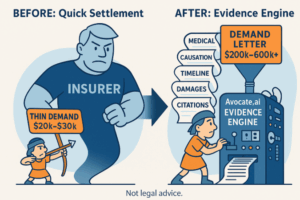Don’t Settle First. Build Your Case First.
If you’ve been hurt by toxic mold exposure, medical malpractice, or outright fraud, the worst-kept secret in civil litigation is this: most people settle far below what their case is really worth. The traditional playbook is designed to move files, not to surface every dollar of harm you’ve suffered. You call a trial lawyer, they screen the facts fast, they estimate a “reasonable” demand, and they try to get something done quickly. That path may secure a check, but it often leaves a lot of money on the table.
Before you call anyone, arm yourself.
At Avocate.ai, we start from a different premise: your demand should reflect the full economic reality of your loss—medical, occupational, environmental, financial, and human. That means we read what others skip, we correlate what others silo, and we cite what others hand-wave. When every fact is counted, settlement math changes.
Why quick settlements end up small
A busy firm is juggling dozens of matters. Deep discovery early—reviewing all records, commissioning targeted testing, mapping timelines, and modeling lifetime costs—takes time and money. So initial demands tend to anchor on what’s easy to prove with the documents immediately at hand. That can push a $200–300k reality down to a $20–30k opening ask. The defense knows the playbook, too; they respond to thin demands with thin offers.
The problem isn’t that lawyers don’t care. It’s the economics of the process: limited time, limited budget, and the constant temptation to “get something done” rather than build the trial-quality record that actually scares insurers.
The evidence gap (and why it matters)
Insurers don’t pay because you “feel” harmed; they pay when evidence links negligence to damages with a clear, well-documented chain:
-
Medical & environmental causation: clinic notes, imaging, lab results, toxicology, mycotoxin or air-quality tests, building inspection reports.
-
Exposure timeline: lease or purchase docs, HOA or property records, maintenance logs, remediation invoices, contractor photos, emails, and texts.
-
Economic loss: pay stubs, tax returns, FMLA records, disability filings, caregiver invoices, relocation receipts, mileage logs, educational or childcare impacts.
-
Future damages: actuarial life-care plans, projected earnings curves, out-of-pocket medical trajectories, and therapy compliance costs.
When your demand letter weaves those strands together with citations and exhibits, the defense has to confront a case that would look credible in front of a jury, not just a claims adjuster. That’s the difference between a nuisance payment and a meaningful settlement.
What Avocate.ai does differently
Think of Avocate.ai as a litigation-grade evidence engine. We don’t guess. We systematically surface, organize, and quantify the facts that move numbers:
-
Ingest everything: medical records (EMR), imaging, lab and pharmacy logs, inspection reports, emails, photos, claims notes, and billing. If it documents your harm, it goes in.
-
Extract signals: our tooling flags missed diagnoses, conflicting chart entries, exposure windows, code violations, and cost-of-care items that frequently get ignored.
-
Build the timeline: minute-by-minute where necessary—linking who knew what, when, and what they did (or didn’t) do.
-
Quantify losses: past and future medical, lost wages/earning capacity, relocation and remediation, supportive care, and other consequential costs.
-
Cite the science and standards: guidelines, peer-reviewed literature, building codes, OSHA/EPA/CDC materials, and payer benchmarks—all referenced.
-
Draft a demand that’s hard to ignore: every claim tied to an exhibit; every dollar mapped to a calculation you can defend.
The result? A demand package that doesn’t feel like a “please pay me” letter; it reads like a pretrial brief backed by receipts.
“10× or more” isn’t magic—it’s math
Picture a household facing a $250,000 reality: months of breathing issues after a leak, ER visits, specialty consults, missed work, relocation, and a child now needing ongoing care. A thin demand might count some ER bills and a few weeks of lost wages. A full accounting will factor:
-
cumulative medical encounters over time (not just the obvious ones),
-
the trajectory of future care (specialists, meds, devices),
-
the true employment impact (downtime, demotion risk, lost promotion path),
-
relocation and remediation costs, and
-
family spillover (childcare, school, mental health).
When you add them up—properly documented—the ask multiplies. Not because we shouted louder, but because we proved more.
“But I thought I needed a lawyer first?”
You should absolutely have qualified counsel when you’re ready to file or negotiate. The point is sequence. If you show up to that first attorney meeting with a well-organized evidence set and a valuation model—rather than a shoebox of receipts—you set a completely different anchor. You also make your matter more attractive to the right trial lawyer, because you’ve de-risked the early work that normally eats their time and budget.
Avocate.ai isn’t a law firm and doesn’t give legal advice. We build the factual backbone and the valuation logic that help you (and later, your chosen counsel) negotiate from strength.
How to start, practically
-
Collect: medical portals (EMR downloads), lab results, prescriptions, HR/payroll exports, building reports, photos/video, landlord or contractor communications, insurance EOBs.
-
Describe: a simple timeline—symptoms, visits, moves, repairs, missed work—month by month.
-
Upload: we securely ingest the lot and run targeted follow-ups to fill gaps.
-
Review: you’ll see a citation-rich draft demand and a damages model you can understand and defend.
If it doesn’t materially improve your position, you don’t move forward. If it does, you’ll walk into any negotiation—or any lawyer’s office—with a case instead of a claim.
Contact Avocate.AI > contact@avocate.ai
The bottom line
Quick settlements are convenient fo r everyone except the person who was harmed. Don’t let your future get priced by the speed of someone else’s workflow. Document first. Quantify fully. Demand precisely. When every piece of your story is evidenced, organized, and valued, the conversation changes—from “what’s the least we can pay?” to “what will a jury believe?”
r everyone except the person who was harmed. Don’t let your future get priced by the speed of someone else’s workflow. Document first. Quantify fully. Demand precisely. When every piece of your story is evidenced, organized, and valued, the conversation changes—from “what’s the least we can pay?” to “what will a jury believe?”
If you’re staring at a lowball offer for mold exposure, malpractice, or fraud, don’t settle for it. Start where outcomes actually move: with the evidence. Avocate.ai will help you build it—so you can recover what the harm truly costs.
Disclaimer: This article is for informational purposes only and is not legal advice. Avocate.ai is not a law firm. Consider consulting a licensed attorney about your specific situation.



